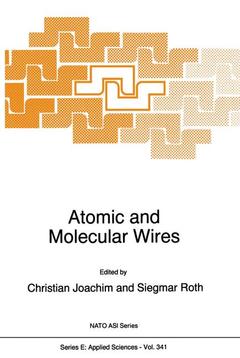Atomic and Molecular Wires, Softcover reprint of the original 1st ed. 1997 NATO Science Series E: Series, Vol. 341
Langue : Anglais
Coordonnateurs : Joachim C., Roth Siegmar

This volume contains the proceedings of the NATO Advanced Research Workshop on "Atomic and Molecular Wires". It was sponsored by the Ministry of Scientific Affairs Division special program on Nanoscale Science with the support of the CNRS and the Max Planck Institute. Scientists working or interested in the properties of wires at a subnanoscale were brought together in Les Houches (France) from 6 to 10 May 1996. Subnanoscale wires can be fabricated either by surface physicists (atomic wires) or by synthetic chemists (molecular wires). Both communities present their foremost advances using, for example, STM to assemble atomic lines atom for atom, to fabricate a mask for such a line or using the wide range of chemical synthesis techniques to obtain long, rigid and conjugated oligomers. Interconnecting such tiny wires to sources (voltage, current) continues to demand a great technological effort. But nanolithography associated with microfabrication or STM are now clearly identified paths for measuring the electrical resistance of an atomic or a molecular wire. The first measurements have been reported on Xe , benzene, C ' di(phenylene-ethynylene) showing 2 60 the need for a deeper understanding of transport phenomena through subnanowires. Such transport phenomena like tunnel (off-resonance) transport and Coulomb blockade have been discussed by theorists with an emphasis on the exponential decrease of the tunnel current with the wire length versus the ballistic regime of transport.
Atomic Wires.- Self assembling of metal lines on metal surfaces.- Self-assembled single atom wide metal lines on Si(001) surfaces.- Atomic depassivation and metallization of the Si(100)-2x1:H Surface.- Controlled manipulation of atoms and molecules and formation of nanostructures with the Scanning Tunneling Microscope.- Molecular Wires.- Organic molecular wires: theoretical analysis of the electronic coupling to metal electrodes and of the influence of derivatization.- Synthesis for molecular electronics: rigid rods and discs.- Synthesis of molecular scale wires and alligator clips.- Synthesis of conjugated ladder oligomers.- Synthesis of nanowires encapsulated in carbon nanotubes by the arc discharge method.- Contacting the wire: Planar junction.- Molecular rectification.- Nanopatterning of conducting polymers and conductivity measurements with nanometer-spaced electrodes.- Towards electrical transport on single molecules. First results on nanafabrication and phthalocyanine polymers.- Co-planar nanojunction to connect a single molecule.- Conductance quantization in metallic nanocontacts: experimental results and novel theoretical aspects.- Contacting the wire: STM junction.- Electrical resistance of one or two atoms.- Contacting molecular nanostructures. Molecular mechanics, charge Transfer, and transport properties.- Computation of electrostatic fields around carbon tubules biased by an STM junction.- A proposal of atom electronics based on atom/molecule switching devices.- Transport theory.- Molecular wires: resonances, staircases, rectification, bonding and speculation.- Tunnel transport through a molecular wire.
Date de parution : 10-2012
Ouvrage de 232 p.
16x24 cm
Thèmes d’Atomic and Molecular Wires :
Mots-clés :
© 2024 LAVOISIER S.A.S.
